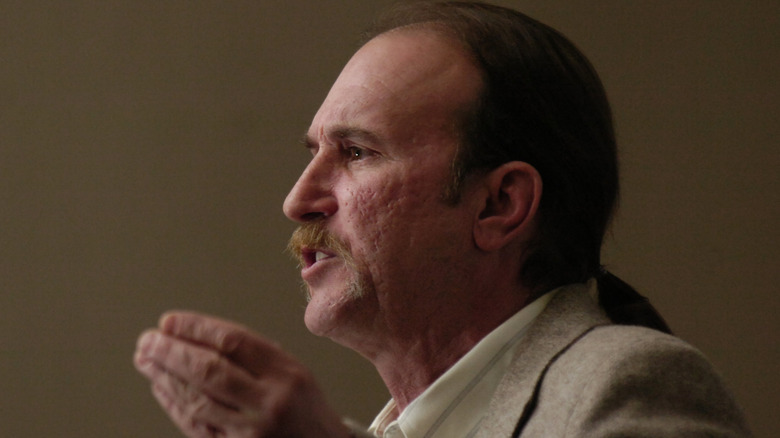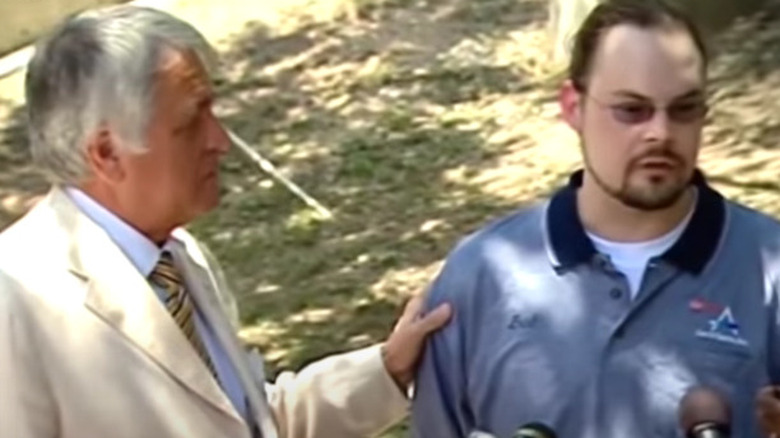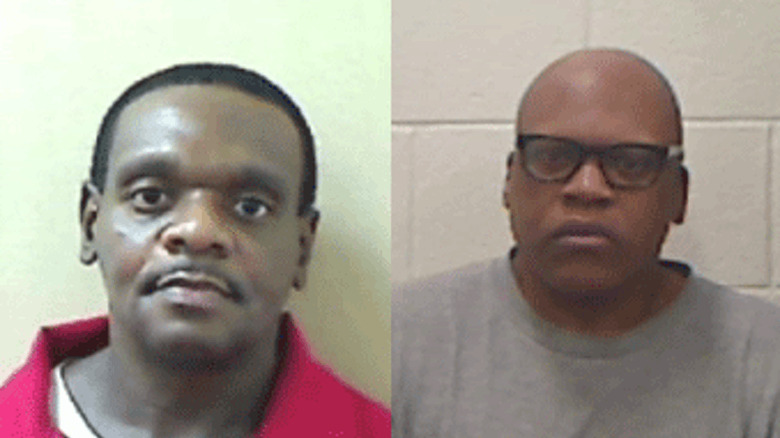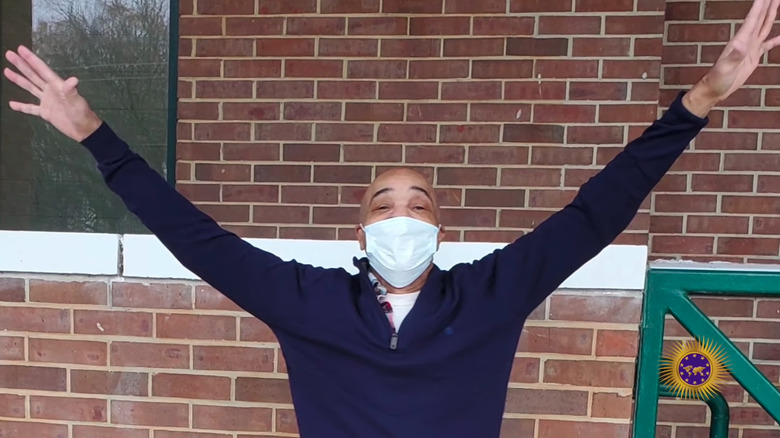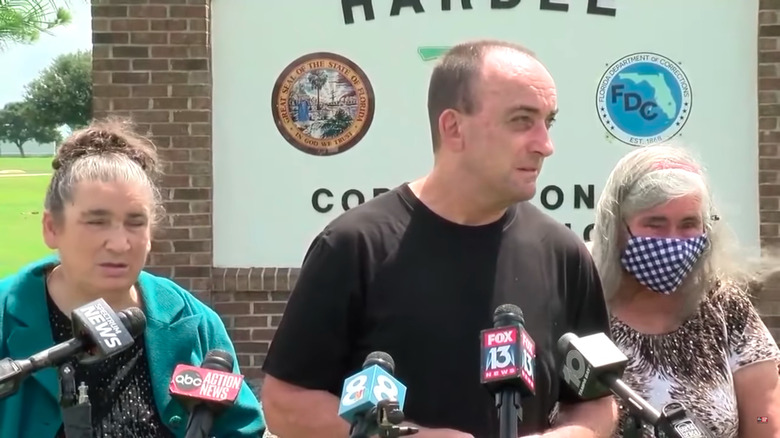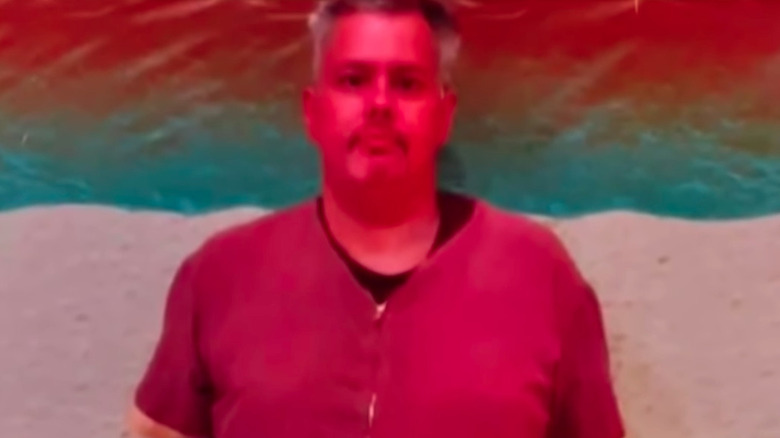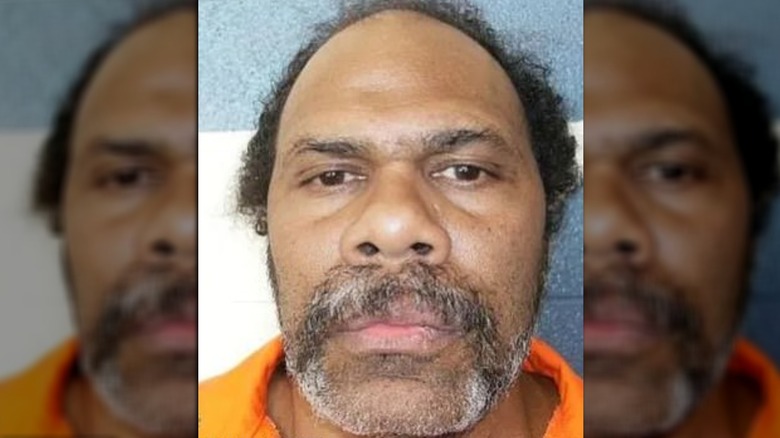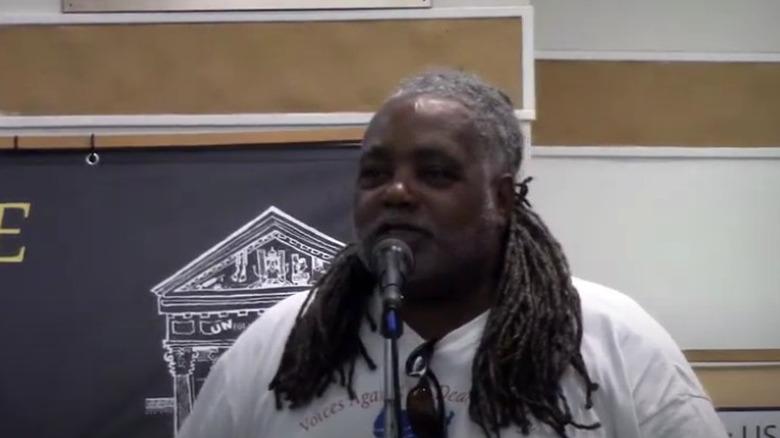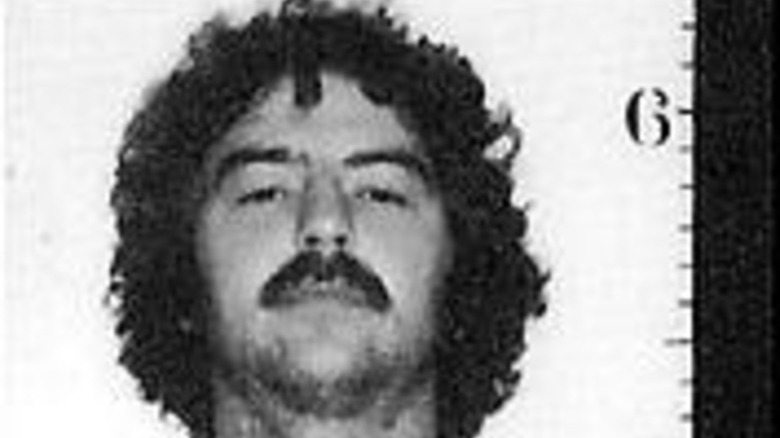People On Death Row That Were Exonerated By DNA
While Lady Justice is supposed to be blind and fair, sometimes the scales of justice she holds tips in one direction against an individual. And other times, officers, informants and the forensic lab tips the scales themselves in their own favor. While that is bad enough, the punishment for some of these false convictions is the individual's life. According to The Guardian, in the United States, at least 4.1% of the people who have been executed were found to be innocent of the crime that landed them on death row. This means the states have essentially used the law of their land to legally commit murder.
This a terrifying thought as state officials, like any other person, hold biases, beliefs, ideas and are full of human errors that led them to put an innocent person on death row. Institutional racism and wealth disparity has also illustrated the all-to-real truth that there are two different systems of justice in the U.S.
The past few decades have seen organizations fight to challenge controversial court rulings, re-examine evidence and law officials, and free innocent individuals imprisoned before their judgment day comes upon them. Here are just a few people on death row who were exonerated thanks to DNA evidence.
Kirk Bloodsworth
According to The Innocent Project, Kirk Bloodsworth was the first person to be exonerated off of death row by DNA testing. In 1993, Bloodsworth had already spent nine years in prison after being convicted of the assault and murder of a 9-year-old girl in Maryland. His conviction was due in large part to several eyewitnesses who made false identifications of Bloodsworth.
As told by Death Penalty Info, his conviction was also the result of the state withholding exculpatory evidence in the defense's favor. In 1992, Bloodsworth received the best news of his life: DNA testing proved he was not guilty of the crime. He said this about that moment. "I remember that day I got that Post-It note stuck in my cell door. It said, 'Urgent! Call your attorney! Kirk, you're innocent.'" The next year, Bloodsworth was released from prison. However, his journey back to everyday life was not an easy one.
"People there wrote anonymous things in the dirt by my truck, and left notes on my windshield —child killer, murderer ... You have to rebuild, and some people don't make it. They will never be the same again."
Still, Bloodsworth has found a new purpose in life. He has become an anti-death penalty activist, as well as active in activism for wrongfully convicted citizens. In 2004, the federal government established a program bearing Bloodsworth's name to fund post-conviction DNA testing for convicted citizens trying to prove their innocence, notes The Innocent Project.
Ray Krone
By 1996, Ray Krone must have believed that his chances of being released from prison were close to none. Four years early, Krone was sentenced to death for the murder, kidnapping, and sexual assault of 36-year-old Kim Ancona. According to The Innocent Project, the main piece of evidence against Krone was that he was seen with the victim the same night of her murder, and bite marks that supposedly matched Krone were found on the victim.
Krone was able to appeal for a second trial, only to once again to be convicted largely because of the bite marks. The judge, seemingly ignoring the long-standing precedent of reasonable doubt, gave Krone a life sentence instead of a death sentence, saying that the bite marks could have come from another person.
Still, Krone did not stop proclaiming his innocence, and in 2002, his salvation came. DNA testing found that the bite marks came from another man, Kenneth Phillips. Phillips was already in prison for an unrelated sex crime and was never questioned by police despite his close vicinity to the victim. In April 2002, Krone was freed from prison.
According to Lee Lofland, Krone, like Kirk Bloodsworth, became an activist upon his release from prison. He is a member of Witness of Innocence, a group that looks to abolish the death penalty and is made up of people wrongly convicted and who were on death row.
Robert Springsteen
When Robert Springsteen was just 17-years-old, he was one of the prime suspects in a quadruple murder of four girls around his age, as told by The National Registry of Exoneration. Largely based on the confession of a fellow suspect, Michael Scott, Springsteen and two others were arrested in 1999. During a long interrogation, Springsteen himself confessed to the crime, though he claimed it was the result of coercion and a marathon interrogation. He was originally convicted and sentenced to death in May 2001, but a Supreme Court ruling dictated death could not be used for underage defendants.
The next year, Scott was sentenced to life in prison, with the prosecutor using his own videotaped interrogation that he also claimed was made under coercion. In 2006, following appeals from Springsteen, the conviction was overturned as the judge ruled Springsteen's 6th amendment rights were violated. Scott followed his colleague the next year. According to Death Penalty Info, as the state was set for a second trial of the two, DNA evidence proved that the two boys and the others were not at the crime scene. The state declined to retrial the two men. Prosecutors are still attempting to find a match to the DNA evidence.
Despite losing almost a decade of their lives to false convictions, the two wrongly convicted men did not receive any compensation from the lawsuits they filed. Both were dismissed in state and federal court.
Henry McCollum and Leon Brown
When Henry McCollum was 19 and Leon Brown was 15, the two half brothers looked at spending their remaining days in a North Carolina prison. The two brothers had confessed to the assault and murder of 11-year-old Sabrina Buie. According to Death Penalty Info, the confessions the brothers signed were far from gathered ethically. Both men have low IQs (McCollum in the 60s and Brown's around the high 40s) and said they did not understand what they were signing.
"I'd never been under such pressure, people yelling and screaming at me. I was scared, and was just trying to get out of that police station and go home," said McCollum.
Both brothers were initially given the death penalty, but during a second trial, Brown's conviction for the murder was thrown out and he was sentenced to life in prison, reports The News & Observer. In 2010, Brown contacted the North Carolina Innocence Inquiry Commission. They discovered DNA at the crime scene that didn't belong to the brothers but to another man named Roscoe Artis, who was serving a life sentence for a similar crime. In September 2014, the two brothers were freed. According to The News & Observer, McCollum was almost put to death in 2006 but was able to block the execution thanks to a series of lawsuits. He is the seventh North Carolinian on death row to be freed from prison. During his three decades behind bars, McCollum saw 42 men he thought of as brothers executed.
Eddie Lee Howard
Almost a mirror of the Ray Krone case, 2021 saw Eddie Lee Howard released after nearly three decades on death row. According to The Innocent Project, Howard's conviction relied heavily on a bite mark that was said to match Howard's teeth, like in the Krone case. However, after DNA evidence and witnesses came forward, 2020 ended with Howard being taken off death row before being released from prison soon after.
Howard was the 28th case of an exoneration following deeper forensic analysis of a bite mark. As of 2021, The Innocence Project, which pushed to overturn the conviction, is working on two more cases that relied on bite mark evidence. The Mississippi Supreme Court both vacated Howard's conviction, as well as discredited the bite mark comparison technique, saying this in its ruling: "Individual perpetrator cannot be reliably identified through bite mark comparison."
Convicted for the assault and murder of an elderly woman in 1994, Howard's conviction was overturned three years later but largely based on the alleged bite mark, he was convicted once again in 2000 and re-sentenced to death, as told by Death Penalty Info. In 2016, Howard's lawyers used DNA evidence to show Howard was nowhere near the crime scene or the victim, as well as disproved the bite mark.
Robert DuBoise
Another prisoner, another bite mark. Robert DuBoise was convicted of the sexual assault and murder of 19-year-old Barbara Grams in 1983. At sentencing, as explained by Death Penalty Info, the jury unanimously recommended that he be sentenced to life without parole. Despite this, the judge decided to ignore the recommendations of the jury and put DuBoise on death row.
Five years later, the Florida Supreme Court overturned the judge's decision, saying that the trial judge should not have overridden the recommendation of the jury and re-sentenced DuBoise to life in prison. According to Bay News 9, Hillsborough's Conviction Review Unit discovered DNA evidence that proved DuBoise's innocence and implicated two different men. With the new evidence and the bite mark evidence being discredited by modern science, DuBoise was exonerated in September 2020.
State Attorney Andrew Warren said following the exoneration he would be working more with the Innocence Project to review the county's convictions that relied on bite mark evidence. DuBoise had this to say after being released from prison and fully exonerated after 37 years behind bars: "I've just been kind of laying low waiting for this day, and now I'm going to try to get on with my life ... I can actually take it in, when other people go out of their house to go to work in the morning, jump in their car, and they're gone. They never lookup. I appreciate everything."
Kareem Johnson
Unfortunately, the case of Kareem Johnson illustrates the issues with police misconduct in the city of Philadelphia. According to the Equal Justice Initiative, all six of the individuals exonerated off death row in Philadelphia were convicted largely because of this fact. Johnson's case was a combination of police misconduct, inefficient representation. and false forensic evidence that was overturned through DNA.
According to Death Penalty Info, Officer William Trenwith testified that Johnson had shot Walter Smith at so close of a range, Smith's blood was splattered on Johnson's red hat left at the scene. Philadelphia's homicide prosecutor, Matthew Barry, echoed this theory to the jury, which led to a guilty conviction in 2006 and a death sentence the next year.
In reality, there was no blood on Johnson's red hat but instead on a black hat worn by the murder victim at the time. This then raised inquiries about the sweat on the red hat, which through DNA testing was found not to be Johnson's.
In order to cover themselves, Philadelphia's DA office in 2015 agreed the conviction should be overturned — not for misconduct but for "ineffective assistance of counsel at the guilty-innocence phase of trial." In May 2020, the Supreme Court of Philadelphia ruled that the prosecution had engaged in misconduct and denied Johnson a fair trial. Two months later, Johnson was a free man.
Walter Ogrod
Walter Ogrod's case was one of the greatest miscarriages of justice in recent memory. According to Injustice Watch, Ogrod was convicted for the attempted sexual assault and murder of 4-year-old Barbara Jean Horn. However, the conviction came in large part because of two jailhouse informants who entrapped Ogrod and a confession written by a Philadelphia detective and signed by Ogrod.
As told by Death Penalty Info, after the first trial ended in a mistrial, the prosecutor enlisted a jailhouse informant named John Hall. Hall had his wife write to Ogrod as a stripper to try to gain damaging evidence in their letters. After this, Hall took the information to another informant named Jay Wolchansky, who falsely claimed that Ogrod had confessed. This led to Ogrod being convicted and sentenced to death in 1996.
In 2020, DNA testing proved Ogrod had no connection to Horn's murder. The evidence was so strong in support of Ogrod's innocence that Horn's mother, Sharon Fahy, advocated for his release. After reviewing the case, Philadelphia District Attorney's Conviction Integrity Unit said the conviction was "a gross miscarriage of justice." The trial was tainted with police and prosecutorial misconduct and false informant testimony. The medical examiner knew that Horn was not beaten to death but died of asphyxia. The prosecutor hid this fact at trial, as well as information about the two jailhouse informants.
Paul Browning
In 1986, 29-year-old Paul Browning was convicted for the armed robbery and murder of a 60-year-old shop owner. The attorney that represented him had practiced law for only a year and failed to interview the officers about the evidence against his client. If he had done so, he might have found that officers had manipulated, misrepresented, and withheld evidence against Browning, as told by Death Penalty Info.
Originally tried and convicted in 1986, Browning's death sentence was overturned in 2004 by Nevada's Supreme Court as a result of ineffective counsel. However, a second jury reinstated the death penalty three years later.
At this point though, the state's evidence were starting to show cracks. Prosecutors had hidden key evidence that proved Browning's innocence, manipulated eye witness testimony, misrepresented blood evidence, and did not disclose a deal made with a key witness who may have been the true murderer. One of their witnesses, a white woman who swore to have seen Browning flee the crime scene, had told officers, "they all look the same, and that's just what I think when I see a black person" when they pressed her on if she was sure it was Browning.
The key evidence of a bloodstain on Browning's jacket was proved not to be the victim's through DNA testing. As told by The National Registry of Exonerations, Browning was freed after 33 years in 2019. He filed a federal lawsuit the next year.
Rudolph Holton
In January of 2003, Rudolph Holton walked free for the first time in 16 years. According to Fore Justice, Florida Supreme Court Justice Barbara Pariente called the case one of the strongest she had seen in favor of a guilty person's innocence. The exoneration itself came from the forensic lab, recanted testimony from two witnesses, and DNA evidence that proved that the hair found on Holton was not that of the victim.
Death Penalty Info states that at the original 1986 trial, the prosecutor told the jury that hairs found in the victim's mouth belonged to Holton. He was convicted of sexual assault and murder and sentenced to death. However, the prosecution withheld evidence that the victim was assaulted more than a week before her murder, and DNA evidence tested on the hair found in the victim's mouth showed that it belonged to the victim herself and not to Holton. The new evidence led Holton and his team to spend 2001 and 2002 in Florida's court system. In 2001, the state's circuit court vacated the original sentencing and by December 2002, the state's Supreme Court upheld the lower court's judgment.
Harold Wilson
According to Death Penalty Info, Harold Wilson came within eight days in 1996 of being executed for a crime he did not commit. If not for the stay of execution fought on Wilson's behalf by Robert Dunham, then the director of the Pennsylvania Capital Case Resource Center, in order to give him a month to continue to investigate Wilson's conviction, Wilson would have been executed.
The Philadelphia Inquirer details that for 17 years while on death row, Wilson was held in solitary confinement. In 1989, he was found guilty of a triple murder in Philadelphia, and prosecutorial misconduct can be found at the center of this case. Philadelphia Assistant District Attorney Jack McMahon, the original prosecutor of the case, was found to use racist tactics to eliminate Black jurors from the trial. Upon discovery of this in 2003, Wilson was granted a new trial, which ended in a mistrial when the prosecution left gruesome photos of the crime in view of the jury. The second trial ended in Wilson's acquittal. Blood found on the killer's jacket that was thought to be Wilson's, as well as three of the victims, was found not to belong to Wilson upon DNA testing. Wilson became an anti-death penalty advocate before passing away in 2019 at the age of 61.
Ronald Keith Williamson
It is a very steep drop from a step away from Major League Baseball to five days until your execution. This is the case of Ronald Keith Williamson, who served 11 years in prison for the sexual assault and murder of Debra Sue Carter. His fellow innocent, Dennis Fritz, was sentenced to life in prison while Williamson was sentenced to death, as told by The Innocence Project.
Drafted in 1971 in the second round of baseball's amateur draft, Williamson's career was ended prematurely because of a shoulder injury. Dejected and never making it to the big leagues, he returned home to try to put his life together. In 1988, he and Fritz were convicted of the assault and murder of a waitress at a bar they regularly attended. Hairs were found on the victim's person belonging to the two men, though this forensic testing would prove to be unreliable.
Originally appealing separately, the two men joined together in regards to DNA testing, which not only proved their innocence but implicated the state's main witnesses against them, a man named Glenn Gore. After spending 11 years in prison, the two men were exonerated.


